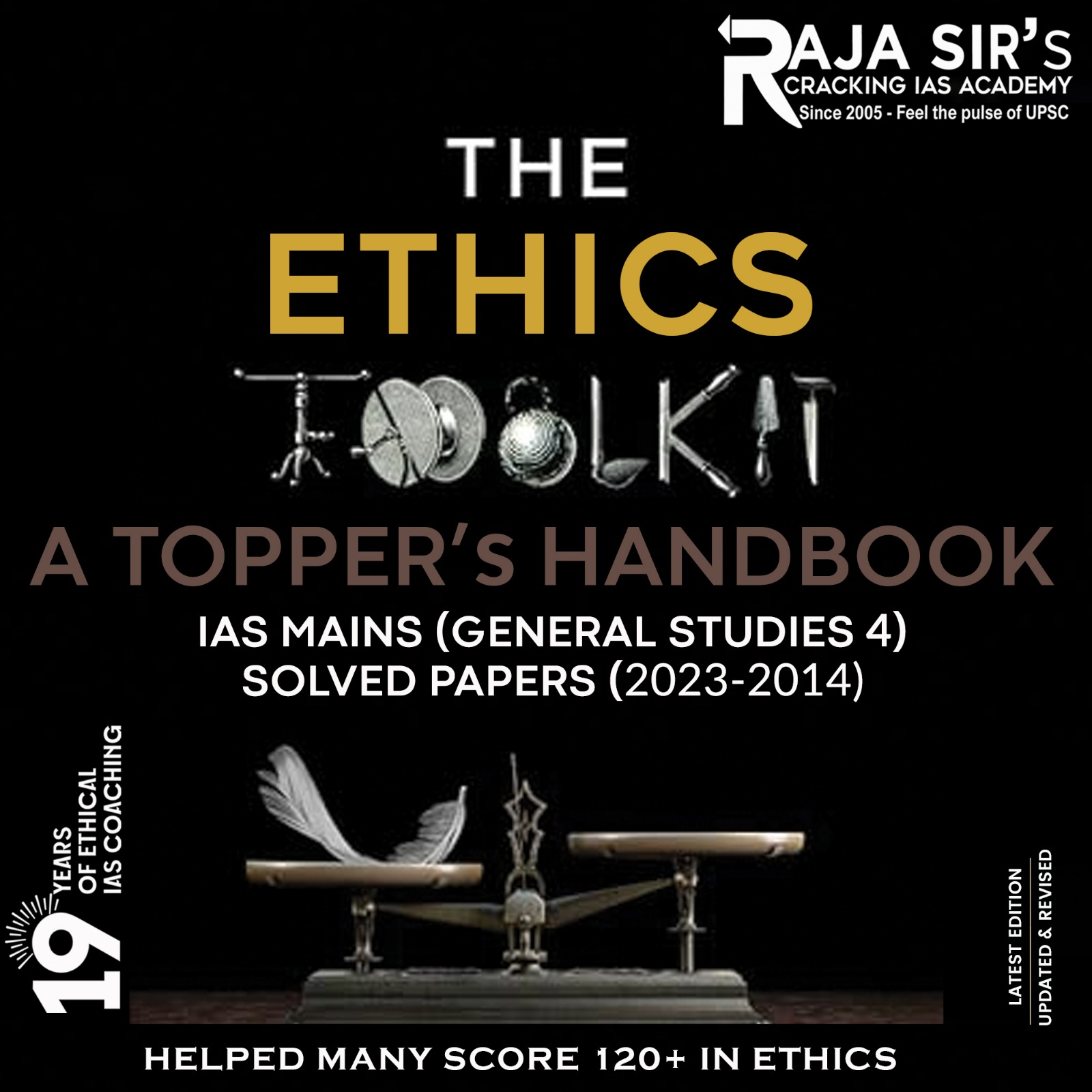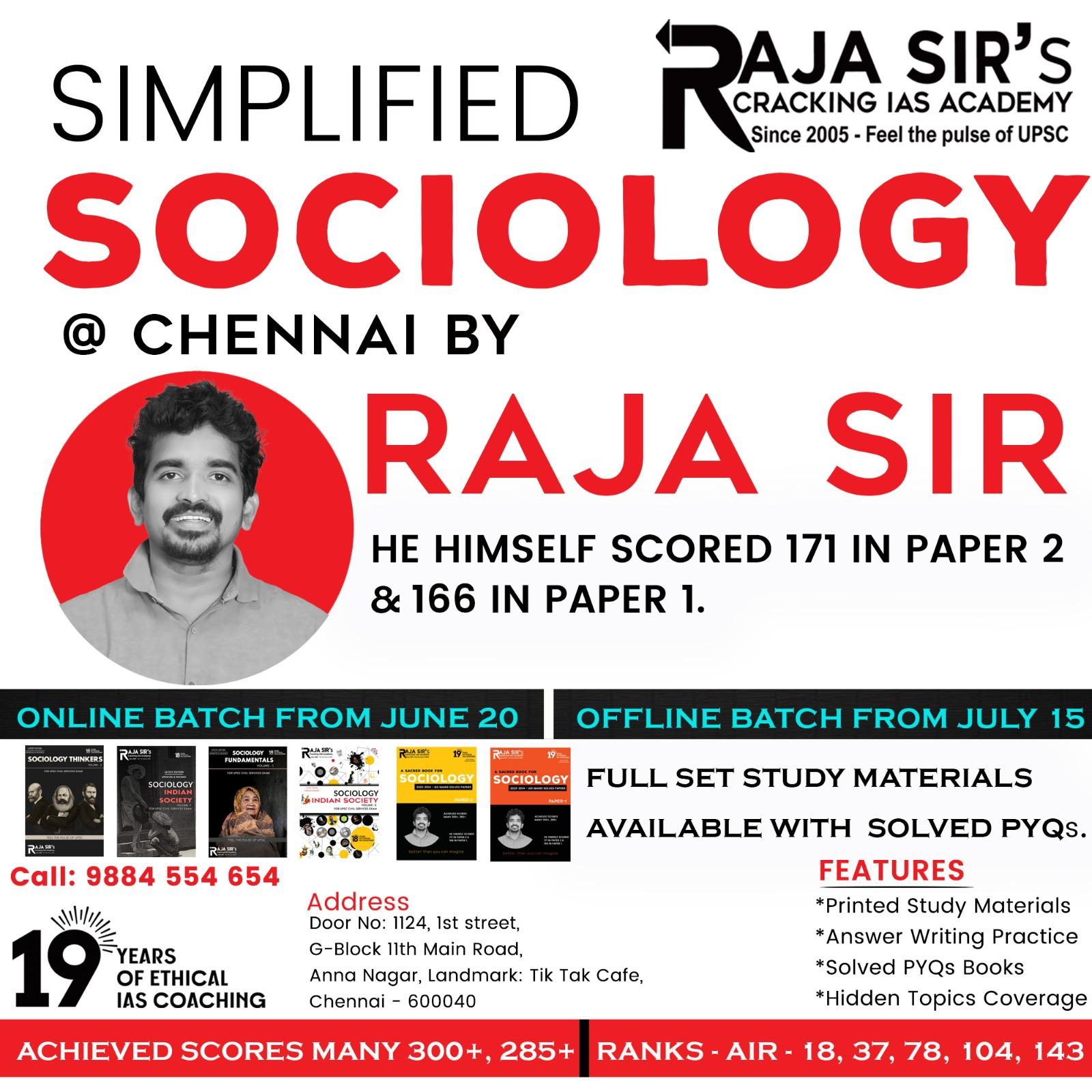- Home
- Prelims
- Mains
- Current Affairs
- Study Materials
- Test Series
Hit List Questions 70-PPP 100 PRELIMS 2024 - 88
Questions & Explanations:
|
1. |
1. The Iqta system was provided constitutional status by Iltutmish. 2. Iqtas were made hereditary by Sultan Firoz Shah Tughlaq. Which of the statements given above is/are correct w.r.t. “iqta system”? (a) 1 only (b) 2 only (c) Both 1 and 2 (d) Neither 1 nor 2
|
|
2. |
The case of Anuradha Bhasin v. Union of India (2020) is related to (a) Issue of transparency in Electoral Bonds (b) Internet Shutdowns (c) Auctioning of spectrum (d) Surrogacy law
|
|
3. |
1.Lakshmana temple 2.Vishwanatha temple 3.Kandariya Mahadeva temple Khajuraho temple complex comprise of (a) 1 and 2 only (b) 1 only (c) 1 and 3 only (d) 1, 2 and 3
|
|
4. |
The irrigation tax was charged on the farmers for the first time by (a) Firoz Tughlaq (b) Mohammad Tughlaq (c) Alauddin Khilji (d) Ghiyasuddin Tughlaq
|
|
5. |
Consider the following statements with reference to LVM3: 1. Its third stage uses a Cryogenic engine, which uses liquefied oxygen and hydrogen as fuel. 2. It is primarily designed to launch communication satellites into geostationary orbit. Which of the statements given above is/are correct? (a) 1 only (b) 2 only (c) Both 1 and 2 (d) Neither 1 nor 2
|
|
6. |
Which of the following statements is/are correct? 1. Washington Treaty gets its power from Article 51 of the United Nations Charter. 2. The foundations of the North Atlantic Treaty Organization were officially laid down on 4 April 1949 with the signing of the Washington Treaty. Select the correct answer using the code given below: (a) 1 only (b) 2 only (c) Both 1 and 2 (d) Neither 1 nor 2
|
|
7. |
Consider the following statements w.r.t. Jizyah during Delhi Sultanate period. 1. Hindu subjects were subjected to Jizyah as a tax paid in lieu of military service by the sultan and armies. 2. Firoz Shah Tughlaq made Jizya a separate tax. 3. Jizyah was imposed on Brahmins, who were earlier exempted, by Firoz Shah Tughlaq. Which of the statements given above is/are incorrect? (a) 1 and 3 only (b) 2 and 3 only (c) 2 only (d) None of these
|
|
8. |
Which of the following statements is/are applicable Jain doctrine? 1) The surest way of annihilating Karma is to practice penance. 2) The ultimate truth and reality are complex. 3) The simultaneous acceptance of multiple, diverse, even contradictory viewpoints. Select the correct answer using the codes given below: (a) 1 only (b) 2 and 3 only (c) 1 and 3 only (d) 1, 2 and 3
|
|
9. |
Consider the following statements w.r.t.” Polyhydroxyalkanoates”. 1. They are used as bio-pesticides. 2. They are polyesters produced by fermenting raw vegetable materials with a series of bacterial strains. Which of the statements given above is/are correct? (a) 1 only (b) 2 only (c) Both 1 and 2 (d) Neither 1 nor 2
|
|
10. |
Which of the following statements is/are correct w.r.t. Pandavula Gutta? 1. It is known for rock paintings. 2. It is older than himalayas. Select the correct answer using the code given below: (a) 1 only (b) 2 only (c) Both 1 and 2 (d) Neither 1 nor 2
|
|
11. |
Consider the following statements w.r.t. Helium stars: 1. They emit more ultraviolet radiation than main sequence stars. 2. They are Hydrogen depleted stars. Which of the statements given above is/are correct? (a) Only 1 (b) Both 1 & 2 (c) Only 2 (d) Neither 1 Nor 2
|
|
12. |
Which of the following is/are true w.r.t. Article 31C in Constitution of India? I. It was inserted by the 25th Amendment Act of 1971. II. It has granted an ‘complete Immunity ‘from Judicial Scrutiny to a law, if the president certifies that it was enacted to Promote the policy laid down under article 39(b)(c). III. It was amended in 1976 by 43rd Constitutional Amendment Act. (a) Both I & II (b) Both II & III (c) Only I & III (d) I, II & III
|
|
13. |
Consider the following statements regarding the Mathura school of art: 1. The Mathura school of art depicts a transition in theme from Brahmanical to Buddhist themes. 2. The Mathura style focuses on the internal beauty and facial sentiments rather than bodily gesture. 3. Buddha is depicted in his Abhay Mudra and Padmasana Mudra. 4. The images of Siva and Vishnu along with their consorts Parvathi and Lakshmi were also carved out in the Mathura school. Which of the statements given above is/are correct? (a) 1 only (b) 1 and 2 only (c) 2 and 3 only (d) 1, 2, 3 and 4
|
|
14. |
Which of the following has the love story of the son of the founder of Sunga dynasty? (a) Kumārasambhava (b) Abhijñānaśākuntalam (c) Raghuvaṃśa (d) Malavikagnimitra
|
|
15. |
Consider the following statements regarding Gandhara Art: 1. Bamyan Buddha of Afghanistan is an example of Gandhara Art. 2. It was closely associated with Mahayana Buddhism. 3. Sakas and Kushanas were the main patrons of this school of art. Which of the statements given above is/are correct? (a) 1 and 2 only (b) 1 and 3 only (c) 2 and 3 only (d) 1, 2 and 3
|
|
16. |
Which of the following features is/are associated with the ‘Deula’ style of temple? 1. Khakra 2. Only pyramidal Shikharas used 3. Boundary walls 4. Erotic Images on the interior as well as exterior walls of Konark Sun Temples (a) 1, 2 and 3 only (b) 1, 3 and 4 only (c) 1 and 3 only (d) 2, 3 and 4
|
|
17. |
Consider the following statements w.r.t. “The IceCube observatory”. 1. It is a device at the Earth’s North Pole. 2. It has detected seven astrophysical tau neutrinos. Which of the statements given above is/are correct?. (a) 1 only (b) 2 only (c) Both 1 and 2 (d) Neither 1 nor 2
|
|
18. |
Which of the following is/are true about ‘Atoms4Climate’ initiative? (a) It was launched by Nuclear Suppliers Group. (b) Its aims to push for nuclear energy as climate solution. (c) Both (a) & (b) are correct. (d) Neither (a) nor (b) is correct. |
|
19. |
“Warkari movement” was within the context of (a) Bhakti saints (b) Sufis (c) Jains (d) Buddhists
|
|
20. |
Identify the incorrect pair. (a) Kanad – Physics (b) Nagarjuna - Chemistry (c) Baudhayan - Mathematics (d) Varahmihir - Medicine
|
|
21. |
“High-Ambition Coalition” seen in news intends to (a) Conserve Wetlands (b) Control Plastic Pollution (c) Regulate GHG Emissions (d) Reduce E wastes
|
|
22. |
Consider the following: The arrival of Babur into India led to the (1) introduction of gunpowder in the subcontinent (2) introduction of the arch and dome in the region’s architecture (3) establishment of Timurid dynasty in the region Select the correct answer using the code given below. (a) 1 and 2 only (b) 3 only (c) 1 and 3 only (d) 1, 2 and 3
|
|
23. |
“Nahal Haredi” seen in news refer to (a) a terrorist organisation (b) a refugee camp (c) a shale gas site in Iran (d) a defence unit |
|
24. |
Identify the correct statement (s) (a) Bhakti movement brought in a system of pahul. (b) Geet and qawali were the literary compositions of Bhakti Saints. (c) Both (a) & (b) are correct. (d) Neither (a) nor (b) is correct
|
|
25. |
‘Anoop Baranwal vs Union of India’ case is related to (a) Appointment of Election Commissioner (b) Appointment of Supreme Court Judges (c) General Consent of CBI (d) Delhi Power tussle
|
EXPLANATIONS
|
1. |
The conquest of Mohammad Ghori and establishment of the Sultanate brought major changes in the land revenue system in India. The Governments in those times made all attempts to increase the revenue by collecting taxes as per those in Islamic nations. The new taxes were imposed upon people and government’s share in produce increased. However, till that time, the original form of Hindu system of Land tenure as per ancient Manu’s laws survived with some modifications done by some of the greedy sultans and their officials.
The agricultural and land revenue system of the early Turkish Sultans rested on two foundations viz. the Iqta (assignment of land revenue) and Kharaj (Land Revenue).
The Iqta system provided an agrarian system to the country while the members of the ruling class attained income without any permanent attachment to any territory. The Iqta system was provided institutional status by Iltutmish and later this system became the mainstay of the sultanate administration under slave dynasty.
Iqta System Under Iqta System, the land of the empire was divided into several large and small tracts called Iqta and assigned these Iqtas to his soldiers, officers and nobles. In the beginning, an Iqta was based upon salary. Later, under Firoz Shah Tughlaq it became hereditary.
Literally, Iqta means land or land revenue assigned to an individual on certain conditions. The holders of these Iqtas were the trustful agents of the Sultan. There were two kinds of Iqtas viz. Large Iqtas and Small Iqtas. The holders of large Iqta were the provincial governors, who had some administrative responsibilities also. On the other hand, the holders of the small Iqtas were the small troops holders who had no administrative responsibilities.
The small Iqta holders held and appropriated all the income obtained from the cultivators but as a quid pro quid, they were bound to present themselves with horses and arms whenever called upon by the Central Government. These small Iqta holders were called Khuts and Muqaddams. Amir Khusarau, for the first time, referred to Khuts as Zamindars.
The Khuts and Muqaddams became fond of luxurious living over the period of time, later, Alauddin Khilji suddenly abolished the system of small Iqtas with a stroke of pen and brought them under the central Government (thus called Khalsa land). This was regarded as one of the most important agrarian reforms of Alauddin Khilji. |
C |
|
2. |
B |
|
|
3. |
D |
|
|
4. |
Firoz Shah Tughlaq was the cousin brother of Muhammad Bin Tughlaq, and became the ruler of Delhi on 23rd march 1351 A.D. He imposed only four taxes sanctioned by Islamic viz., kharaj (land tax), khams (1/5 of the looted property during wars), Jizya (religious tax on the Hindus), and Zakat (2½per cent of the income of the Muslims which was spent for the welfare of Muslim subjects and their religion). He imposed irrigation tax after getting it sanctioned from the Ulema.
|
A |
|
5. |
C |
|
|
6. |
A |
|
|
7. |
D |
|
|
8. |
1. The surest way of annihilating Karma is to practice penance: - Jainism believes in the concept of Karma, which is the accumulation of both good and bad actions. These karmas bind the soul to the cycle of birth and death. Penance, which involves self-discipline, self-control, and self-mortification, is considered a means to purify the soul and eradicate the karmas. By practicing penance, individuals can reduce and ultimately annihilate their karmas, leading to spiritual liberation.
2. Every object, even the smallest particle has a soul: - Jainism upholds the belief in the existence of souls in all living beings, including plants, animals, and humans. However, Jain doctrine goes further by stating that souls also exist in non-living entities such as rocks, water, and even in the tiniest particles. This belief is based on the concept of anekantavada, which asserts that reality is multifaceted and cannot be fully comprehended from a single perspective.
3. Karma is the bane of the soul and must be ended: - Jainism considers karma as the main obstacle to the liberation of the soul. The accumulation of karma is seen as a burden that keeps the soul trapped in the cycle of birth and death. The ultimate goal of Jain practice is to free the soul from the bondage of karma and attain moksha (liberation). This can be achieved through various means, including right faith, right knowledge, and right conduct, which involve following the principles of non-violence, truthfulness, and spiritual discipline. |
D |
|
9. |
Polyhydroxyalkanoates (PHAs) are bioplastic and a sustainable and eco-friendly alternative to synthetic plastics. PHAs can be entirely synthesized using various microorganisms such as bacteria, algae, and fungi. These value-added biopolymers show promising properties such as enhanced biodegradability, biocompatibility, and other chemo-mechanical properties. |
b |
|
10. |
C |
|
|
11. |
B |
|
|
12. |
· Article 31C was added by Constitution (25th Amendment) Act, 1971 by than Prime Minister Indira Gandhi. It was added to provide supremacy of Directive Principles over Fundamental Right. Article 31C undermines Article 14 (Equality before law & Equal protection of law). · Article 31C provides immunity from scrutiny by Supreme Court i.e Supreme Court can''t question the violation of Fundamental Rights mentioned under Article 19, Article 14 or Article 31 in case any state policy violates them. · This article enhanced the utility of the Directive Principles, which stood the testimony of the Supreme Court in Kesavananda Bharati Case 1973. · With the intention of abolishing ‘Zamindari System'' and distribution of lands to the poor this Article was bought. · It was amended once in 1976 by 42nd Constitutional Amendment Act but again restored to its original form after the ‘Minerva Mills Limited’ vs ‘Union of India Case’ 1980. |
A |
|
13. |
Mathura School · Initially, in Gandhara style, a complex form of symbolism was present and Mathura style deviated from it by establishing the tradition of transforming Buddhist symbols into human form accordingly Buddha’s first image can be traced to Kanishka s reign. · The Mathura School flourished on the banks of the river Yamuna in the period between 1st and 3rd centuries B.C. · In Mathura, an indigenous style of sculpture developed, and it mostly used red sandstone. · Mathura School of art is famous for its assimilative character since the images of Vaishnava and Shaiva faiths along with Buddhist images are in prevalence in Mathura style. · The sculptures of the Mathura School were influenced by the stories and imageries of all three religions of the time – Buddhism, Hinduism and Jainism. · The images of Siva and Vishnu along with their consorts Parvathi and Lakshmi were also carved out in the Mathura school moreover the female figures of yakshinis and apsaras of the Mathura school were beautifully carved too. One thing to note that the images of Shiva and Vishnu were depicted by their ayudhas (weapons). · The records of Jain Tirthankars are also found in Mathura Style. · The Hindu Gods were represented using their avayudhas. · The Mathura style focuses on the internal beauty and facial sentiments rather than bodily gesture. · Yaksha images found during the Mauryan period. Characteristics of Mathura School of Art · In Mathura style more, the focus was laid on the internal beauty and facial sentiments rather than bodily gesture. · There is boldness in carving the large images as the first Mathura image creators never aimed to sculpt an anatomically correct human Buddha. · Progression in Mathura School of Art · Initially, in early stages the images of Buddha and Bodhisattva are fleshy, with little spirituality and more happiness (faces are round and smiling), garments clearly visible, close-fitting robes almost entirely devoid of folds. · Later in 2nd, 3rd and 4th Century AD the extreme fleshiness kept on reducing progressively and images got sensual. Additionally, the halo around the head of Buddha was excessively decorated. |
D |
|
14. |
Malavikagnimitra is a Sanskrit play by Kalidasa. It is known to be his first play. The play tells the story of the love of Agnimitra, the Shunga emperor at Vidisha, for the beautiful hand-maiden of his chief queen. He falls in love with the picture of an exiled servant girl named Malavika. When the queen discovers her husband''s passion for this girl, she becomes infuriated and has Malavika imprisoned but as fate would have it, in the end she is discovered to be of royal birth and is accepted as one of his queens. |
D |
|
15. |
https://niu.edu.in/sla/online-classes/BHS-201_Mathura-and-Gandhara-School-of-Art.pdf |
D |
|
16. |
LINGARAJ TEMPLE · Lingaraja Temple is a temple dedicated to Lord Shiva. · It was built by King Jajati keshari of Soma Vansh. But later additions were done by the Ganga rulers. · It is an example of the Kalinga Style of Architecture. This style broadly comes under the Nagara style. · The temple is built in red stone. · Lingaraj is referred to as ‘Swayambhu” – self-originated Shivling. · Bindusagar lake is located in the north of the temple. Marichi Kunda and Ganga Jamuna are other lakes existing near the temple periphery. · The temple compound is not open to non-Hindus, but there is a viewing platform beside the wall offering a good view of the main exteriors. This was originally erected for a visit by Viceroy Lord Curzon. · It is built in the Deula style that has four components, namely 1. Vimana (structure containing the sanctum), 2. Jagamohana (assembly hall) 3. Natamandira (festival hall) 4. and bhoga-mandapa (hall of offerings) · In Kalinga Architecture, basically a temple is made in two parts, a tower and a hall. The tower is called deula and the hall is called jagmohan. · The walls of both the deul and the jagmohan are lavishly sculpted with architectural motifs and a profusion of figures. · The most repeated form is the horseshoe shape, which has come from the earliest times, starting with the large windows of the chaitya-grihas. It is the deul or deula which makes three distinct types of temples in Kalinga Architecture. · The style consists of three distinct types of temples: Rekha Deula, Pidha Deula and Khakhara Deula. The former two are associated with Vishnu, Surya and Shiva temples while the third is mainly with Chamunda and Durga temples. · The Rekha Deula and Khakhara Deula houses the sanctum sanctorum while the Pidha Deula constitutes outer dancing and offering halls · Examples of Kalinga architecture: Rajarani temple (Bhubaneshwar); Jagganath Temple, Puri. |
C |
|
17. |
The sensors on board IceCube detect Cherenkov radiation produced by neutrinos. Cherenkov radiation happens when electrically charged particles, such as protons or electrons, travel faster than light in a clear medium like water. When this happens, the water molecules and particles interact to give off light. https://indianexpress.com/article/technology/science/ghost-particles-astronomers-neutrinos-9216444/ |
B |
|
18. |
B |
|
|
19. |
Namdev participated in the Warkari movement. Warkari movement was within the bhakti spiritual tradition that was famous in Maharashtra. Believers of this movement worshiped their deity Vitthal who is regarded as a form of God.
This movement is said to represent the Maharashtrian culture. About Vitthal and Warkari Sampradaya, there are many versions. Charlotte Vaudeville argues that Vitthal has a Saivite origin. On the other hand, some scholars like Deleury and Dhere argued that Vitthal was originally the God of nomadic pastoral tribes.
People from different regions have different views on him. In North India, he is considered as a nirgun spiritual saint. While in Maharashtra, it is believed that he is both a nirgun and a sagun bhakt. The saints of the Warkari sect celebrated the unity of nirgun and sagun bhakti. |
A |
|
20. |
In Indian context the contributions of Baudhayan, Aryabhatta, Bhaskaracharya in the field of Mathematics, Astronomy and Astrology; Kanad and Varahmihir in the field of Physics; Nagarjuna in the field of Chemistry, Susruta and Charak in the field of Medicines and Patanjali in the field of Yoga are profound treasures of Indian Cultural heritage. Culture is liable to change, but our heritage does not. We individuals, belonging to a culture or a particular group, may acquire or borrow certain cultural traits of other communities/cultures, but our belongingness to Indian cultural heritage will remain unchanged. Our Indian cultural heritage will bind us together e.g. Indian literature and scriptures namely Vedas, Upanishads Gita and Yoga System etc. have contributed a lot by way of providing right knowledge, right action, behavior and practices as complementary to the development of civilization. |
D |
|
21. |
https://indianexpress.com/article/explained/global-plastic-treaty-canada-significance-9285936/ |
B |
|
22. |
Gunpowder was introduced during the mid-14th century. “Gunpowder,” is a mixture of saltpeter (potassium nitrate), sulfur, and charcoal. The introduction of Islamic architectural features was the greatest contribution of Delhi sultanates. Hence, introduction of the arch and dome in the region’s architecture was done during the period of Delhi Sultanate. The members of the Timurid dynasty were strongly influenced by the Persian culture. It had established Timurid Empire in Persia and Central Asia and the Mughal Empire in the Indian subcontinent. Hence, arrival of Babur led to establishment of Timurid dynasty in the region.
|
B |
|
23. |
The 97th Netzah Yehuda Battalion, previously known as Nahal Haredi is a battalion in the Kfir Brigade of the Israel Defense Forces. The purpose of the unit is to allow Haredi Jewish men to serve as combat soldiers in the Israeli military by creating an atmosphere conducive to their religious convictions in the strict observance of Halakha. |
D |
|
24. |
Pahul was the sanctified water offered by a master to the pupil or shishya as a token of his being accepted as a trainee on his march to godliness.
|
C |
|
25. |
A |









 Latest News
Latest News





 General Studies
General Studies